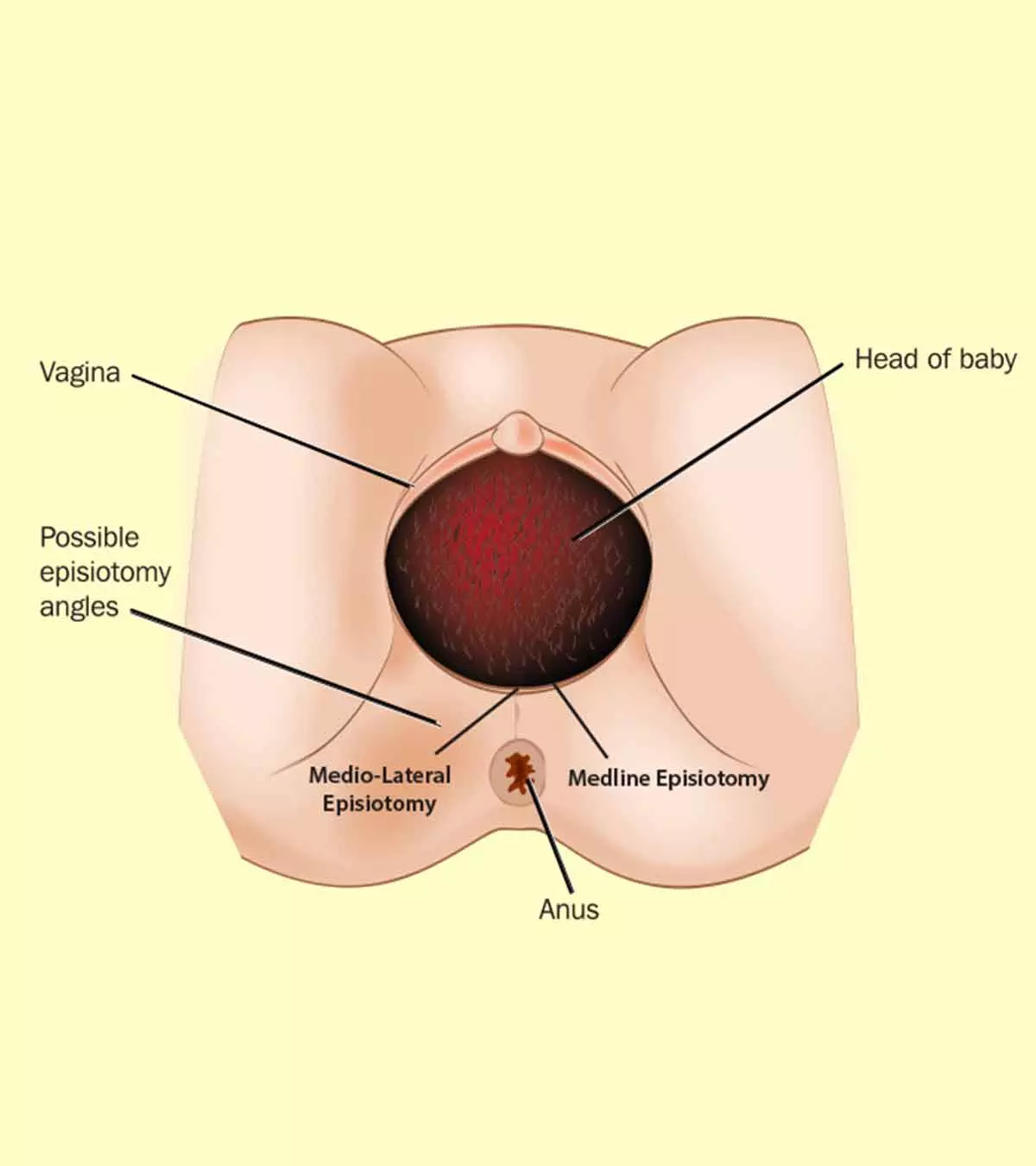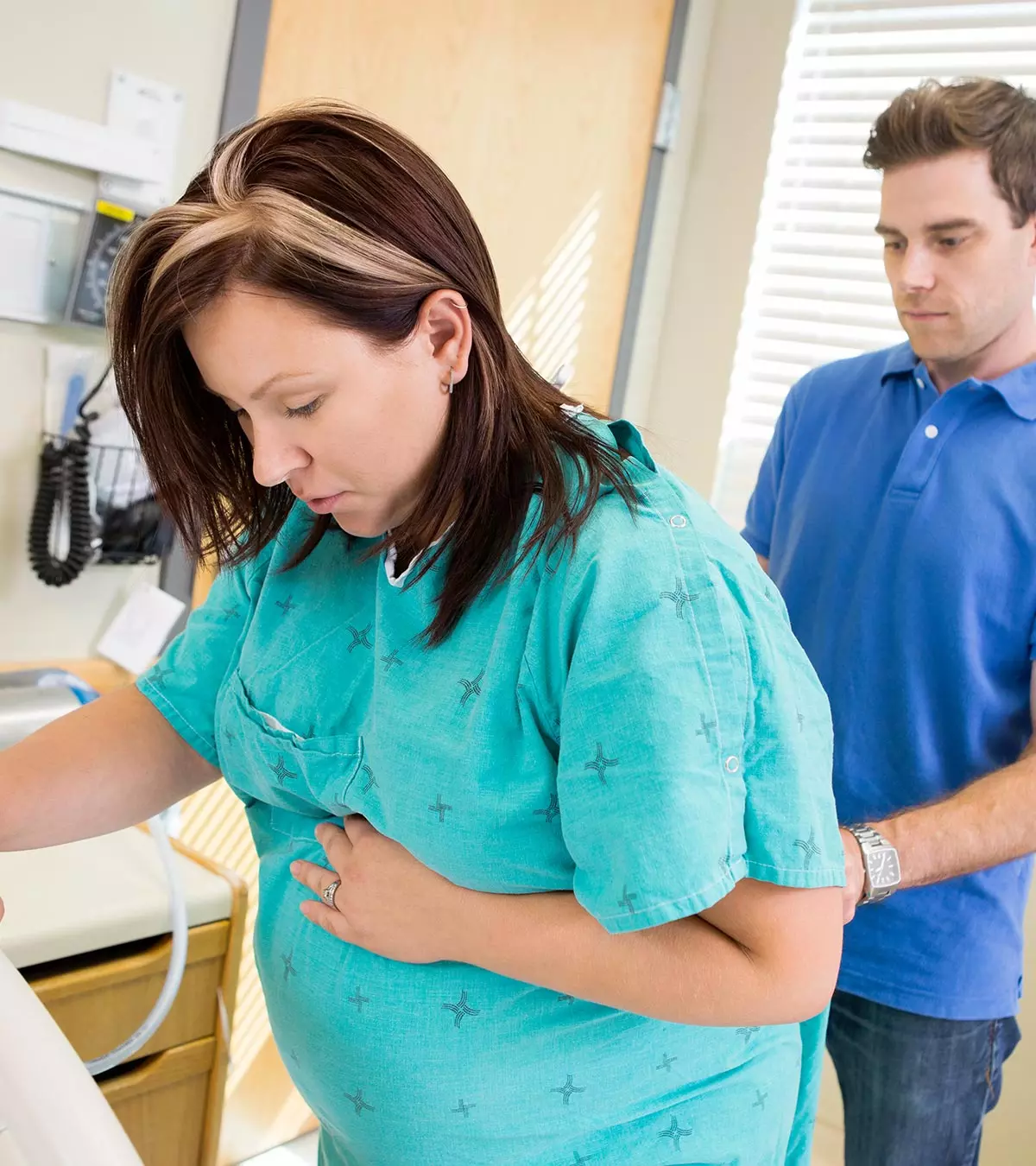

Image: Shutterstock
What is an episiotomy? It is a small incision or cut made in the vagina during childbirth. Obstetricians may inform you of the need for an episiotomy in the labor room if the vaginal opening is not widened enough to pass the baby. Although it was a common practice to avoid vaginal tears during birth, many other delivery methods reduced its need. Therefore, it is only reserved for certain situations.
Read on to learn more about the risks, recovery and healing, and preventive measures related to episiotomy.
What Is An Episiotomy?
Episiotomy is a surgical procedure performed during natural birth, wherein a small vertical incision is made in the perineum to widen the vaginal opening. If you are not given epidural during labor, then a numbing medicine will be injected in the area before the episiotomy (1).
After delivering the baby and removing the placenta, the perineum is stitched using dissolvable sutures. It generally takes around one or two weeks for the perineum wound to heal.
What Are The Different Types Of Episiotomy?
The episiotomy procedure is classified into seven types (2) (3):
- Median or medial episiotomy (midline incision): This incision begins at the posterior fourchette and runs till the central tendon of the perineum along the midline.
- Modified median episiotomy: It involves a transverse incision made perpendicular to the midline, just above the anal sphincter.
- J-shaped episiotomy: This incision begins at the midline, and then laterally curves to resemble the shape of ‘J’.
- Lateral episiotomy: It is a lateral incision of 1-2 cm that begins at vaginal introitus in the midline and is directed towards the ischial tuberosity on either sides.
- Radical lateral (Schuchardt incision): It is similar to lateral episiotomy, but with one variation. The incision begins at the midline from vaginal sulcus and is laterally curved downward, a little away from rectum region. It is generally done during complicated deliveries.
- Posterolateral (mediolateral) episiotomy: It is an incision that starts from the midline and is directed laterally downwards, but away from the rectum.
- Anterior episiotomy: This incision begins at the midline and is directed towards the pubis.
Of these, midline, lateral and mediolateral episiotomies are the most commonly used.
When Is An Episiotomy Required?
Not all the vaginal births need an episiotomy. Conditions that make this procedure necessary include (4):
- Large head or shoulder of the baby that does not fit inside the birthing canal
- Baby is in distress (not getting enough oxygen) and needs to be delivered soon
- Baby in breech position
- The patient is unable to push after trying for several hours
- To minimize health risks and speed up delivery when the woman has serious conditions such as heart disease
- Vaginal delivery using medical interventions such as vacuum extractor or forceps
- The birth is imminent, but the perineum hasn’t stretched enough (5)
- Preterm labor (6)
The procedure may be necessary but can have a few risks.
What Are The Risks Of Episiotomy?
Some of the risks associated with episiotomy include:
- Infection
- Bleeding
- Swelling
- Third-degree tears extending to the anus
- Perineal hematoma (blood collection in the perineal tissues)
- Painful intercourse
- Perineal pain
- Itchy or raised scar tissues (7)
Proper care after delivery is essential to prevent these risks.
Episiotomy Care After Delivery
Here are some tips you can follow to take care of the episiotomy pain and wound to reduce any chances of infection and promote faster healing.
- Keep the area clean: Clean the area properly and use clean cotton towels for wiping. It helps prevent bacteria build-up and minimizes the chance of any infection. Be gentle and wipe from front to back. Avoid rubbing the area as it may cause inflammation.
- Take your medicines on time: If you are in pain, then take the painkiller suggested by your doctor.
- Allow air to pass through: Air passage is necessary for the faster healing of episiotomy wound. So, keep the area free from sanitary pads or clothes for some time.
- Use ice pack: Ice packs help relieve the perineum pain and soothe wounds. You can use chilled hazel pads that can be placed over the sanitary pad and put on.
- Use sanitary pads: Sanitary pads will absorb the vaginal bleeding post delivery and need to be changed frequently to prevent bacterial growth and reduce the chances of infection in the perineum.
- Keep nails short: Applying analgesic cream with long fingernails may cause further damage to the wounds in the perineum. So, it is necessary that you trim your nails before.
- Move around cautiously: Try not to exert any force on the vaginal area while sitting or standing up. Use cushions and avoid sitting on hard surfaces as that may be painful.
- Prevent constipation: Take laxatives to relieve constipation, as difficult bowel movements can put pressure on the wound, making it more painful. It can sometimes result in the loosening of the stitches.
- Soothing vulva while urinating: After urination, pour warm water using a squirt bottle on the wounds to get some relief from the discomfort. Do not wipe the area; instead, pat dry it.
- Avoid sexual intercourse: The episiotomy will be painful and sore the initial few weeks after delivery. So, it is better to avoid sex during this period.
- Pelvic floor exercises: They help strengthen the muscles in the vaginal area and promote faster healing.
- Using sitz bath: It is an excellent way of healing the perineum and can be used even if the doctor has not prescribed it.
- Avoid tampons: It is recommended not to use tampons for six weeks post-delivery.
- Medicinal creams and numbing sprays: Some local numbing sprays or medicinal creams can be applied to the affected area for relief from the pain and faster healing of the wound.
If you feel pain and discomfort even after following these tips, go to the doctor.
When To Call A Doctor?
If you notice the following symptoms, then call the doctor right away:
- Vaginal discharge with foul smell
- Passing large blood clots
- Severe pain at the site of the incision
- No bowel movements for 4 or more days
- Wound breaks open/bleeding from episiotomy site
- Fever or chills (1)
How To Prevent An Episiotomy?
Here are some tips you can follow to minimize the risk of episiotomy:
- Hydration and proper nutrition promote the perineal tissue health and enhance the stretchability of the perineum. Include foods rich in protein, vitamin E, omega-3 and omega-6 fatty acids in your diet (6).
- Practice kegel and pelvic floor exercises during pregnancy to increase the flexibility of the perineum.
- Massaging the perineum at least six weeks before the delivery date makes it flexible.
- Controlled pushing during labor can prevent the need for an episiotomy (4).
- Avoid lying on the back (supine position) while pushing. The lateral and upright birthing positions help reduce the need for an episiotomy (8), (7).
- Take childbirth classes to learn the birthing techniques and positions that can reduce the chances of episiotomy.
Frequently Asked Questions
1. Is it better to tear or have an episiotomy?
Women might experience a vaginal tear while delivering a baby. Some tears might get better within two to six weeks (9).
2. Which episiotomy is more painful?
A comparative study showed no apparent difference in pain between midline and mediolateral episiotomies. However, midline episiotomy might cause more severe perineal tears than mediolateral episiotomies (10).
As a first-time mom, you may want to educate yourself about the various surgical interventions involved in childbirth, including episiotomy. It is a surgical procedure that your doctor could suggest in certain circumstances involving natural childbirth. The procedure could be essential in some situations but carries the risks of blood loss, infection, itching, and pain in the perineum. You may follow some homecare tips to help your stitches heal faster. Speak to your doctor if you develop a fever, unusual vaginal discharge, or intense pain after an episiotomy.
References
1. Episiotomy; Johns Hopkins Medicine
2. Reviewed by A Khetrapal; Episiotomy Procedure; News Medical
3. V Kalis et al.; Classification of episiotomy: towards a standardisation of terminology; BJOG (2012)
4. Episiotomy and perineal tears; NHS (2017)
5. Labour and birth information; Mater (2017)
6. Avoiding Tears and Episiotomies; NotJustSkin (2009)
7. Evidence Based Guidelinesfor Midwifery-Led Care in Labour; The Royal College of Midwives (2012)
8. Midwifery care in labour guidance for all women in all settings;The Royal College Of Midwives
9. Dr. Julie Frohlich and Christine Kettle;Perineal care; National Library of Medicine (2015)
10. Ratchadawan Sooklim et al., The outcomes of midline versus medio-lateral episiotomy; National Library of Medicine (2007)
Community Experiences
Join the conversation and become a part of our nurturing community! Share your stories, experiences, and insights to connect with fellow parents.
Read full bio of Dr. Surakshith Battina
Read full bio of shreeja pillai















